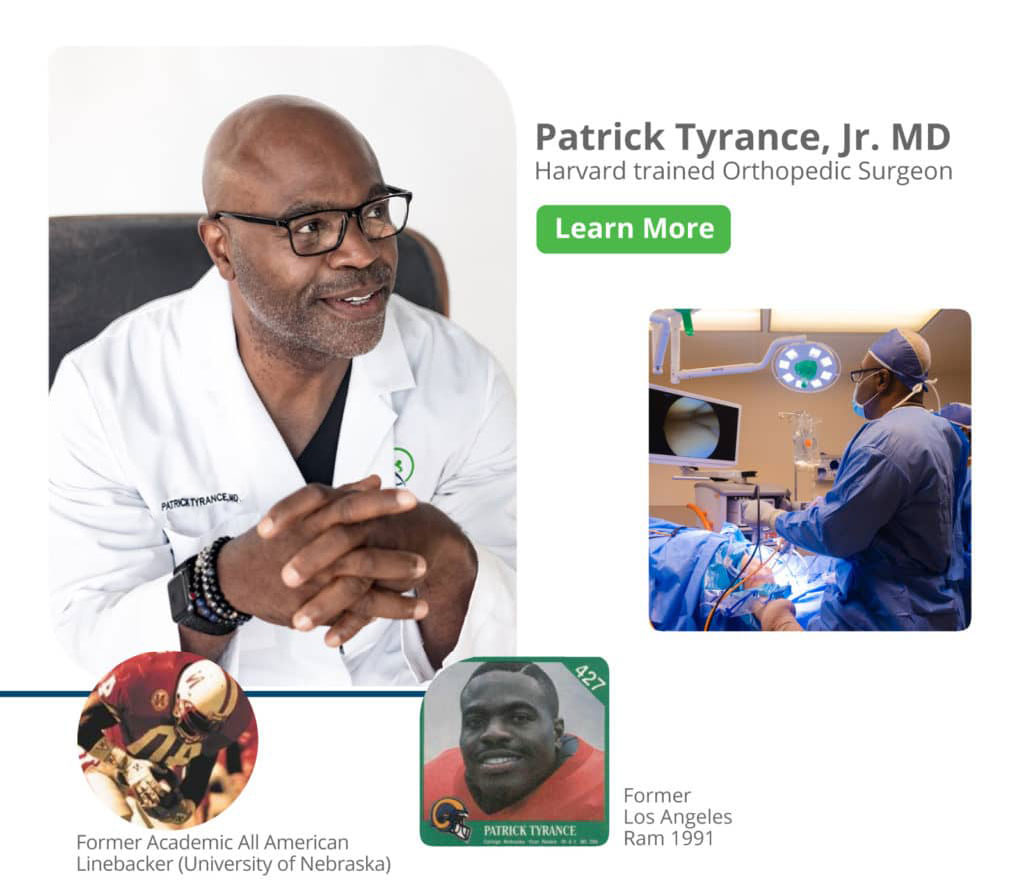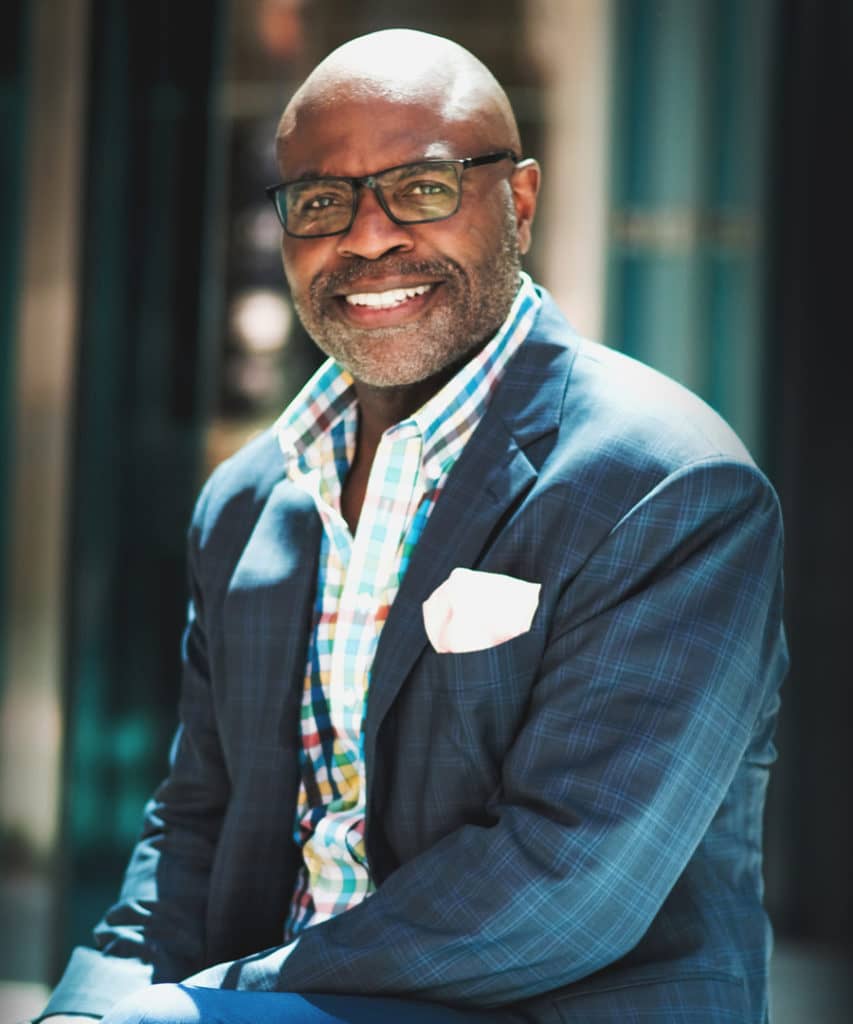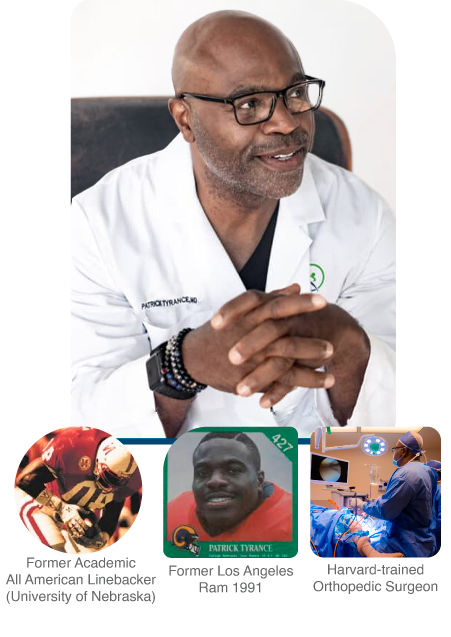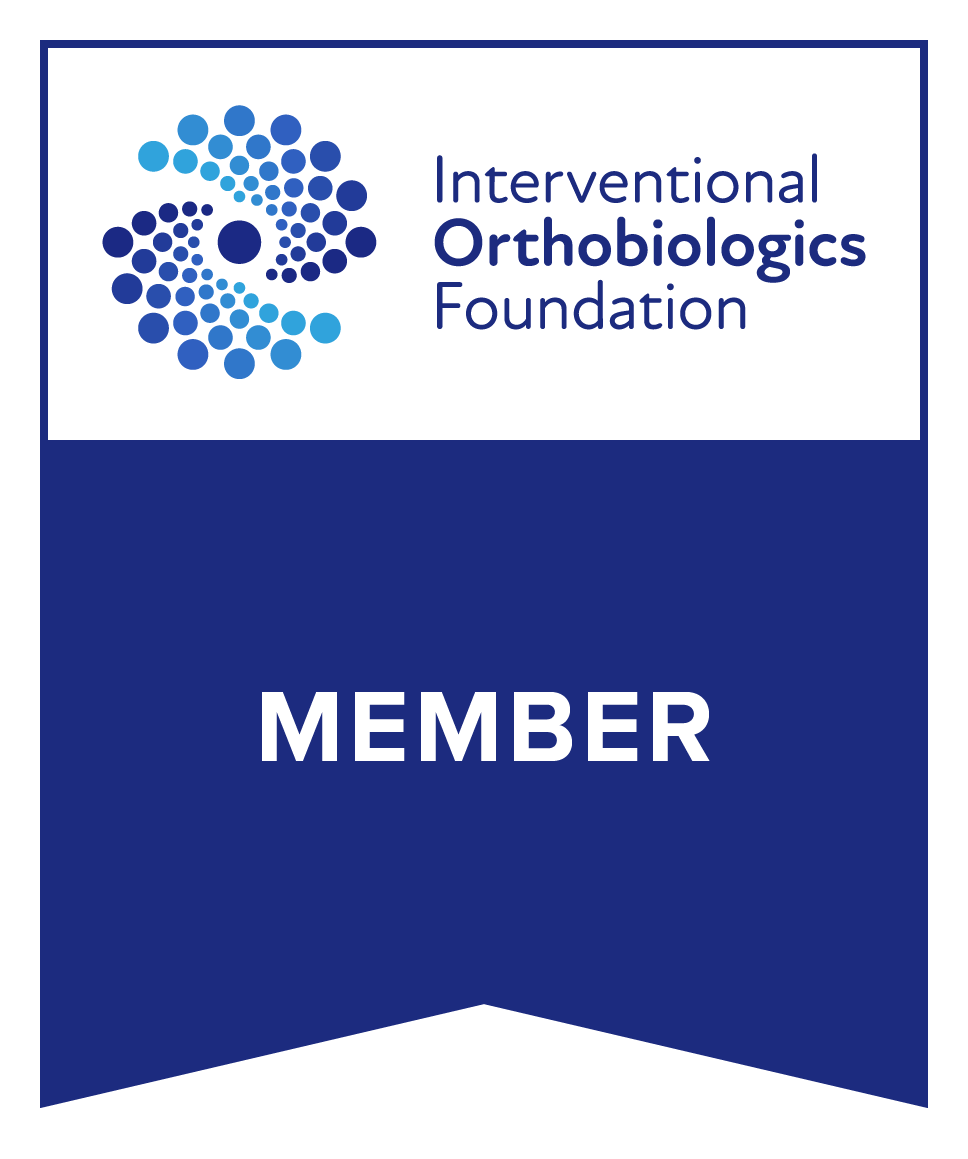Sports Medicine
Welcome To South FL’s Top Orthopedic Center
We specialize in the diagnosis and treatment of musculoskeletal lesions, trauma, post-surgical rehabilitation, arthritis, and sports medicine.
Contact us to learn more or to schedule a consultation
Please fill out the form below and we will get back to you shortly.
Sports Medicine
Welcome To South FL’s Top Orthopedic Center
We specialize in the diagnosis and treatment of musculoskeletal lesions, trauma, post-surgical rehabilitation, arthritis, and sports medicine.
Contact us to learn more or to schedule a consultation
Please fill out the form below and we will get back to you shortly.

Meet the Doctor
Patrick Tyrance, Jr. MD
Dr. Patrick Tyrance Jr. is a Harvard-trained Orthopedic Surgeon and passionate holistic health advocate. Prior to becoming an Orthopedic Surgeon, he was a former All-Conference and Academic All-American linebacker at the University of Nebraska and drafted by the LA Rams before completing medical school and orthopedic surgery training at Harvard.
He is known as a compassionate physician and recognized for his surgical skill. In addition to his private medical practice, Patrick Tyrance, Jr. MD serves as an advisor to a number of healthcare startups and evaluates patented technologies in medicine and healthcare for their commercialization potential.

Sports Medicine
No matter which sport you like to play, it’s no fun missing the action because of an injury. Patrick Tyrance, Jr. MD can help you get back in the game. Using the latest non-operative and operative treatment approaches, we help you heal, regain strength and flexibility so you can return to your favorite activity as soon as possible.
Common sports-related injuries include injuries of the shoulder (rotator cuff, labrum, shoulder separation), knee (anterior cruciate ligament, meniscus), lateral epicondylitis of the elbow, ankle sprains, and fractures.
Patrick Tyrance, Jr. MD specializes in focusing on sports-related injuries, injury management, and rehabilitation, treating a variety of conditions such as:
“Your doctor may recommend surgery if:
You’re an athlete and want to continue in your sport, especially if the sport involves jumping, cutting or pivoting
More than one ligament or the fibrous cartilage in your knee also is injured
The injury is causing your knee to buckle during everyday activities
During ACL reconstruction, the surgeon removes the damaged ligament and replaces it with a segment of tendon ‴ tissue similar to a ligament that connects muscle to bone. This replacement tissue is called a graft.
Your surgeon will use a piece of tendon from another part of your knee or a tendon from a deceased donor.
After surgery, you’ll resume another course of rehabilitative therapy. Successful ACL reconstruction paired with rigorous rehabilitation can usually restore stability and function to your knee.”
Info from: www.mayoclinic.org
“Surgery is most often performed for tendon avulsion injuries, where the tendon has pulled completely away from the bone. Tears from the pelvis (proximal tendon avulsions) are more common than tears from the shinbone (distal tendon avulsions).
Surgery may also be needed to repair a complete tear within the muscle.
Procedure. To repair a tendon avulsion, your surgeon must pull the hamstring muscle back into place and remove any scar tissue. Then the tendon is reattached to the bone using large stitches or staples.”
Info from: orthoinfo.aaos.org
“An ankle sprain refers to tearing of the ligaments of the ankle. The most common ankle sprain occurs on the lateral (outside) part of the ankle. There’s a good chance you may have sprained your ankle at some point while playing sports or stepping on an uneven surface, some 25,000 people do it every day. It can happen in the setting of an ankle fracture (when the bones of the ankle also break). Most commonly, however, it occurs in isolation.
Ankle sprains can be diagnosed fairly easily given that they are common injuries. Pain on the outside of the ankle, tenderness and swelling, and an ankle with an inversion-type injury may indicate a sprain. In these patients, normal X-rays also suggest that the bone has not been broken and instead the ankle ligaments have been torn or sprained.”
“If the tear causes persistent troublesome symptoms, particularly painful locking, then an operation may be advised – although evidence for the benefit of surgery is variable. Several studies have been done that suggest that surgical treatment for people who have a meniscal tear due to wear and tear (degeneration) is no better than following a standard exercise regime.
Most operations are done by arthroscopy.”
Info from: patient.info
“It’s a common injury, especially in sports like baseball or tennis, or in jobs like painting or cleaning windows. It usually happens over time from normal wear and tear, or if you repeat the same arm motion over and over. But it also can happen suddenly if you fall on your arm or lift something heavy.
Types of rotator cuff surgery:
Arthroscopic. Your doctor will make a small cut in your shoulder then use an arthroscope — a tube with a small camera and tiny instruments — to fix the tear. This means your recovery time will likely be shorter than it would with another type of surgery.
Open. Your doctor uses larger instruments to go into the muscles of your shoulder and fix the tear.
Mini-Open. This uses both arthroscopic and open methods. Your doctor starts with the arthroscope and finishes with larger instruments.
Tendon transfer. If your tendon is too torn to reattach, the doctors can use another nearby tendon.
Shoulder replacement. If the rotator cuff tear is large enough, you may need to have your shoulder joint replaced.”
Info from: https://www.webmd.com
“Tennis elbow is also known as lateral elbow pain or lateral epicondylitis and is not necessarily related to tennis. However, tennis players often develop the condition because it stems from repetitive muscle use. The cause of tennis elbow stems from repeating incorrect movements of the arm. This can lead to small tears in the tendon attachment at the elbow. In tennis, this translates to the repeated motion and force of hitting a ball with a racquet.
Incorrect technique can cause the power in the swing of a racquet to rotate through and around the wrist. This creates a movement on the wrist instead of the elbow joint or shoulder. This can increase pressure on the tendon and cause irritation and inflammation.
Several treatment methods can be used at home or after consulting a physician.”
Info from: https://www.medicalnewstoday.com
“Patellar (knee) tendonitis is a sports injury that commonly affects elite athletes. Over time, repeated movements (such as jumping) gradually weaken the patellar tendon in the knee. This knee injury may cause minor to severe pain and discomfort. Left untreated, pain may worsen over time. Rest, rehab exercises and stretching may help your body heal.”
Info from: my.clevelandclinic.org
“Tendinitis or bursitis often involves the shoulder, elbow, wrist, hip, knee and ankle. The pain it causes may be quite severe and often occurs suddenly. As in arthritis, the pain is worse during movement. Unlike arthritis, the pain is often in parts of the body far from a joint. Tendinitis often results from repetitive use (overuse). Though the problem can recur or be chronic (long term) in some people, it is most often short term, mainly if treated early.
Bursitis is inflammation of a bursa. This small sac acts as a cushion between moving structures (bones, muscles, tendons or skin). If a muscle or tendon is pulling around a corner of a bone, or over a bone, a healthy bursa protects it from fraying and stress. When a bursa is inflamed, it becomes very painful, even during rest.”
Info from: www.rheumatology.org
Patrick Tyrance, Jr. MD
Harvard trained Orthopedic Surgeon

Sports Medicine
No matter which sport you like to play, it’s no fun missing the action because of an injury. Patrick Tyrance, Jr. MD can help you get back in the game. Using the latest non-operative and operative treatment approaches, we help you heal, regain strength and flexibility so you can return to your favorite activity as soon as possible.
Common sports-related injuries include injuries of the shoulder (rotator cuff, labrum, shoulder separation), knee (anterior cruciate ligament, meniscus), lateral epicondylitis of the elbow, ankle sprains, and fractures.
Patrick Tyrance, Jr. MD specializes in focusing on sports-related injuries, injury management, and rehabilitation, treating a variety of conditions such as:
“Your doctor may recommend surgery if:
You’re an athlete and want to continue in your sport, especially if the sport involves jumping, cutting or pivoting
More than one ligament or the fibrous cartilage in your knee also is injured
The injury is causing your knee to buckle during everyday activities
During ACL reconstruction, the surgeon removes the damaged ligament and replaces it with a segment of tendon ‴ tissue similar to a ligament that connects muscle to bone. This replacement tissue is called a graft.
Your surgeon will use a piece of tendon from another part of your knee or a tendon from a deceased donor.
After surgery, you’ll resume another course of rehabilitative therapy. Successful ACL reconstruction paired with rigorous rehabilitation can usually restore stability and function to your knee.”
Info from: www.mayoclinic.org
“Surgery is most often performed for tendon avulsion injuries, where the tendon has pulled completely away from the bone. Tears from the pelvis (proximal tendon avulsions) are more common than tears from the shinbone (distal tendon avulsions).
Surgery may also be needed to repair a complete tear within the muscle.
Procedure. To repair a tendon avulsion, your surgeon must pull the hamstring muscle back into place and remove any scar tissue. Then the tendon is reattached to the bone using large stitches or staples.”
Info from: orthoinfo.aaos.org
“An ankle sprain refers to tearing of the ligaments of the ankle. The most common ankle sprain occurs on the lateral (outside) part of the ankle. There’s a good chance you may have sprained your ankle at some point while playing sports or stepping on an uneven surface, some 25,000 people do it every day. It can happen in the setting of an ankle fracture (when the bones of the ankle also break). Most commonly, however, it occurs in isolation.
Ankle sprains can be diagnosed fairly easily given that they are common injuries. Pain on the outside of the ankle, tenderness and swelling, and an ankle with an inversion-type injury may indicate a sprain. In these patients, normal X-rays also suggest that the bone has not been broken and instead the ankle ligaments have been torn or sprained.”
“If the tear causes persistent troublesome symptoms, particularly painful locking, then an operation may be advised – although evidence for the benefit of surgery is variable. Several studies have been done that suggest that surgical treatment for people who have a meniscal tear due to wear and tear (degeneration) is no better than following a standard exercise regime.
Most operations are done by arthroscopy.”
Info from: patient.info
“It’s a common injury, especially in sports like baseball or tennis, or in jobs like painting or cleaning windows. It usually happens over time from normal wear and tear, or if you repeat the same arm motion over and over. But it also can happen suddenly if you fall on your arm or lift something heavy.
Types of rotator cuff surgery:
Arthroscopic. Your doctor will make a small cut in your shoulder then use an arthroscope — a tube with a small camera and tiny instruments — to fix the tear. This means your recovery time will likely be shorter than it would with another type of surgery.
Open. Your doctor uses larger instruments to go into the muscles of your shoulder and fix the tear.
Mini-Open. This uses both arthroscopic and open methods. Your doctor starts with the arthroscope and finishes with larger instruments.
Tendon transfer. If your tendon is too torn to reattach, the doctors can use another nearby tendon.
Shoulder replacement. If the rotator cuff tear is large enough, you may need to have your shoulder joint replaced.”
Info from: https://www.webmd.com
“Tennis elbow is also known as lateral elbow pain or lateral epicondylitis and is not necessarily related to tennis. However, tennis players often develop the condition because it stems from repetitive muscle use. The cause of tennis elbow stems from repeating incorrect movements of the arm. This can lead to small tears in the tendon attachment at the elbow. In tennis, this translates to the repeated motion and force of hitting a ball with a racquet.
Incorrect technique can cause the power in the swing of a racquet to rotate through and around the wrist. This creates a movement on the wrist instead of the elbow joint or shoulder. This can increase pressure on the tendon and cause irritation and inflammation.
Several treatment methods can be used at home or after consulting a physician.”
Info from: https://www.medicalnewstoday.com
“Patellar (knee) tendonitis is a sports injury that commonly affects elite athletes. Over time, repeated movements (such as jumping) gradually weaken the patellar tendon in the knee. This knee injury may cause minor to severe pain and discomfort. Left untreated, pain may worsen over time. Rest, rehab exercises and stretching may help your body heal.”
Info from: my.clevelandclinic.org
“Tendinitis or bursitis often involves the shoulder, elbow, wrist, hip, knee and ankle. The pain it causes may be quite severe and often occurs suddenly. As in arthritis, the pain is worse during movement. Unlike arthritis, the pain is often in parts of the body far from a joint. Tendinitis often results from repetitive use (overuse). Though the problem can recur or be chronic (long term) in some people, it is most often short term, mainly if treated early.
Bursitis is inflammation of a bursa. This small sac acts as a cushion between moving structures (bones, muscles, tendons or skin). If a muscle or tendon is pulling around a corner of a bone, or over a bone, a healthy bursa protects it from fraying and stress. When a bursa is inflamed, it becomes very painful, even during rest.”
Info from: www.rheumatology.org
About Dr. Patrick Tyrance Jr.
Serving Palm Beach & Broward County
About Our General Orthopedics
What our patients say
We believe in earning the trust of our patients, not only by providing the highest quality and leading-edge medical care but also by treating each patient and their family with sincere compassion.
Trustindex verifies that the original source of the review is Google. Had a great first visit today and look forward to working with this great team in the new year!Trustindex verifies that the original source of the review is Google. WOW! What an amazing Doctor! I had rotor cuff surgery with Dr. Tyrance, and had no pain after surgery, out of the sling in 2 days and 6 weeks in I’m already doing resistance physical therapy to strengthen the muscles! I was very anxious before this surgery because everyone I spoke with that had this surgery said they had pain for months.NO PAIN! Great doctor, great staff, especially Ivette!Trustindex verifies that the original source of the review is Google. Thank you for fixing my knees DoctorTrustindex verifies that the original source of the review is Google. ⭐⭐⭐⭐⭐ I had an outstanding experience as a new patient at Tyrance Orthopedics & Medicine. From the moment I walked in, Ivette, the Office Manager, and Ayla at the front desk made me feel incredibly welcome. Their customer service was excellent—friendly, professional, and accommodating. They even asked if I needed anything to drink, which was a nice touch. Dr. Patrick Tyrance was equally impressive. He answered all my questions thoroughly and provided natural alternatives to traditional medicine, which I greatly appreciated. The entire team was engaging and inspiring, making my visit not only pleasant but also informative. I highly recommend Tyrance Orthopedics & Medicine for anyone seeking top-notch orthopedic care. Tony Miller, Wednesday, October 23, 2024, visit.Trustindex verifies that the original source of the review is Google. Dr. Tyrance and staff were amazing! So happy I found him, thorough and transparent, highly recommend for any orthopedic injury sustained.Trustindex verifies that the original source of the review is Google. Fantastic Professional Sports Doctor, highly recommend!!! Felt at home and at ease right away. I felt #Teamwork at play here, which means everything to me as a very active polo player and leader of our team. Teamwork is not just on the polo field but the behind the scenes to make winners win! That you Doctor Tyrance ( he is a NFL Alumni athlete and understands what it takes to maintain the body & mind in pro sports)Google rating score: 4.9 of 5, based on 172 reviews
Frequently Asked Questions
Common sports-related injuries treated include ACL tears, hamstring strains, ankle sprains, meniscal tears, rotator cuff tears, tennis elbow, patellar tendonitis, and shoulder tendonitis and bursitis.
We offer both non-operative and operative treatments to help patients heal from injuries, regain strength, and restore flexibility. The goal is to get you back to your favorite activities as quickly as possible.
Rehabilitation focuses on personalized care to help patients regain strength, mobility, and function after an injury, ensuring a full recovery and a safe return to sports.
Common shoulder injuries include rotator cuff tears, labrum tears, and shoulder separations. These injuries are treated using advanced techniques for both non-surgical and surgical care.
Yes, knee injuries like ACL tears, meniscal tears, and patellar tendonitis are commonly treated. We use the latest techniques to address these injuries and promote recovery.
“We have the ability to reclaim and maintain the mental and physical vitality we had in our youth. Your health is wealth!”
– Patrick H. Tyrance Jr. MD
Get treatment today with one of South Florida’s top Orthopedic Surgeons.
Request A Consultation
Fill out the form below and we will get back with you shortly.


